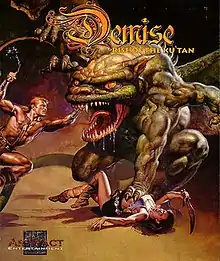Demise: Rise of the Ku'tan
Demise: Rise of the Ku'tan is a medieval fantasy role-playing video game released in 2000 for the personal computer (PC), developed by Artifact Entertainment and published by IPC Software.[2] The game features the same setting as Mordor: The Depths of Dejenol, which was also developed by designer David Allen.[3]
| Demise: Rise of the Ku'tan | |
|---|---|
 | |
| Developer(s) | Artifact Entertainment |
| Publisher(s) | IPC Software |
| Engine | Processor: Pentium-166 Memory: 32 MB RAM Recommended: Processor: Pentium-200 Memory: 64 MB RAM |
| Platform(s) | PC |
| Release | 12 January 2000 [1] |
| Genre(s) | Role-playing video game |
| Mode(s) | Single-player Co-operative multiplayer |
Gameplay
In Demise: Rise of the Ku'tan, Lord Gherrick's realm is attacked by demons emerging from the mines of Dejenol.[3] After the assault is quelled, the player is dispatched into the mines in an attempt to locate and destroy the primordial evil at its center. The game world is split between a town and a dungeon; the former features guilds, a merchant, a morgue and several other locations, while the latter houses monsters, which must be destroyed during the course of the players' explorations. At the outset, users are required to create an avatar with particular racial traits, classes, and starting statistics, and develop the character as they progress within the game. This development is achieved by gaining experience, measured as a statistic, and equipping improved weaponry, found in the dungeon or purchased from the town merchant. Furthermore, the game features up to 16 players in a co-operative multiplayer mode.[3]
A beta version of an expanded version of the game named Ascension was published in 2011 by a group of enthusiastic players headed by Decklin (Richard Whitwell).
Reception
Upon release, Demise: Rise of the Ku'tan received predominately negative reviews. GameSpot were dismissive, arguing that the game lacked either "an engrossing story or an online multiplayer game with a sprawling world to explore."[4] Even the most amiable of reviewers complained of the game's interface, poor graphics and tedious sound effects, while PC Zone commented that the fact "there is 3D acceleration support is risible, as are the graphical options to enable or disable detail and effects."[5] Conversely, positive remarks were made regarding the variety of equipment, spells and the ability to combine classes. Although many reviews were negative upon its release the game gathered a fanbase which remains active, and the GameSpot userscore is 7.0 even in 2013. Fans of games with a high level of difficulty and little help for the inexperienced player praise the game for the apparent complexity that lies beneath the otherwise simple "hack and slash" gameplay.
Availability
Development of the game continues as of August 2016, with the developers having released version 1.06 build 721. The game itself can be purchased from the developer's website. The game will run on most Windows systems including 64-bit platforms. Extensive personal support is provided through the message board on the official site.
References
- "Demise: Rise of the Ku'tan specifications". GameSpot. Archived from the original on 15 July 2012. Retrieved 2 March 2010.
- Seyoon-Park, Andrew (2000-03-07). "Demise: Rise of the Ku'tan review". GameSpot. Archived from the original on 19 July 2010. Retrieved 2 March 2010.
- "Demise: Rise of the Ku'tan summary". MobyGames. Retrieved 2 March 2010.
- Seyoon-Park, Andrew (2000-03-07). "Demise: Rise of the Ku'tan review". GameSpot. Archived from the original on 19 July 2010. Retrieved 2 March 2010.
- Hill, Mark (2001-08-13). "Demise: Rise of the Ku'tan review". Computer and Video Games. Retrieved 2 March 2010.
- "Demise: Rise of the Ku'tan aggregate rating". GameRankings. Retrieved 2 March 2010.